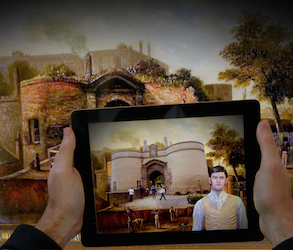Museum objects are not only evidence of our past, but have stories to tell. Telling stories has preserved the identities of individuals and communities and was one the earliest ways of managing knowledge – there was no real distinction between history and story. Storytelling that is interwoven into the museum visitor’s experience can encourage a more subjective and emotional connection to the past by layering competing accounts of historical events beyond the single voice of ‘authority’. Using mobile technologies gives museums the flexibility to tell stories in different ways and to share and create a living history experience for their visitors. Digital storytelling can bridge the gap between explicit information and implicit knowledge that museums and heritage sites often struggle with balancing.
Nottingham Castle was established as the first municipal museum and art gallery outside London in 1878. A castle site since the 11th Century, it has a chequered history of murders, sieges, and intrigue. The medieval castle was destroyed during the Civil War (1642 – 1651) and replaced by a Ducal Palace in 1674. On an October night in 1831, the palace was set alight by rioters protesting against the reform bill. That night left a legacy; a unique combination of diverse eyewitness accounts and museum objects.
The exhibition explores the theme of Riots focusing on the 1831 Nottingham Reform Bill Riot and its effects on the Castle museum’s site through a digitally integrated augmented reality (AR) experience. It incorporates AR as an active storytelling medium which helps the visitor to develop an understanding of the relationships between the ‘real’ and ‘virtual’ objects. The curatorial relationship between the digital and physical exhibition is carefully considered and the AR app was developed to bring a new perspective on the historical collection. iPads have been dispersed throughout the gallery, in front of paintings and objects in display cabinets, creating an intermingling of virtual and real objects, the past and the present.

Although there are other examples of AR in museums, there are very few that exploit the benefits of the dynamic elements of 3D virtual environments (computer games) and animation. AR is an evocative storytelling medium which can combine theatrical site specificity, the realtime capabilities of computer games and cinematic aesthetics, with traditional museum practices, particularly interpretive narrative.
Although the story follows a linear narrative that begins with the news of the Reform Bill’s rejection in parliament and ends with the Castle on fire, the visitor’s experience is non-linear. Their experience may not follow a chronological journey since the exhibition space has three different entrances. The visitor’s curiosity will have to lead their exploration and interpretation. Each AR story episode has been designed to be viewed independently. The context in which the experience is viewed is also significant; a visitor using their smart phone will have a different experience to the visitor using the iPad provided in the exhibition.
The design and construction of the AR stories used storytelling techniques from cinema, theatre and computer games and also had an understanding of the limitation and boundaries of the digital medium. In the case of a wall mounted painting of the Castle Gatehouse – the augmentation ‘brings the painting to life’ and allows it to extend beyond the frame into the Gallery space. During the course of the story the visitor moves around their mobile device to view the virtual scene. Each interaction with the silhouetted Rioters advances the story by moving the rioters closer to the Gate.

The spatial relationship is a unique element of AR and can be used to great effect to immerse the viewer. The 360 degree panoramic realtime augmentation means the visitor is surrounded by an unbroken view of the virtual images within their surroundings. The viewer’s field of vision is restricted by the dimensions of the screen and the extent of the virtual projections into the space can only be seen within this frame. The visitor controls their view by moving their device around the space as though viewing a panoramic shot in a film.
The intention of this project is not to provide photorealism, nor is it a virtual re-enactment of the 1831 Riots. Instead, it aims to create a dramatisation of the eyewitness accounts of the events, designed to help the visitor feel connected to the people of the past. Events and images progress through coexisting physical and virtual narrative paths which sees the gallery space become a promenade performance where the AR stories, the museum objects and the location merge.
Riot 1831@Nottingham Castle is a project supported by the Digital R&D Fund for the Arts – Nesta, Arts and Humanities Research Council and public funding by the National Lottery through Arts Council England. It will open on 4th July.
Back to top




